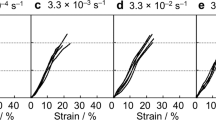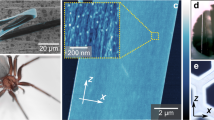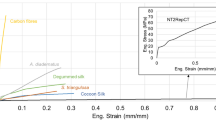Abstract
IN previous papers1 it has been established that alkali treatment of fresh preparations of silk fibroin gives rise to the appearance of new equatorial small-angle reflexions which were believed to be higher orders of a ground-period of 45 A. At first this effect was ascribed to a structural change of the silk lattice. Continued investigations, however, made it very likely that the new reflexions are due to some waxy substances. This assumption has now been confirmed by means of the following experiments: (1) The new reflexions disappear if the sample is treated with 1: 1 ether–alcohol for 8 hr. at 40° C. (2) After removing the solvent by evaporation, a waxy substance (1.6 per cent of the weight of the degummed silk) is obtained. This is in good accordance with the data of other authors, who have found 1–2 per cent wax in Bombyx mori silk2. The extracted substance shows sharp reflexions corresponding with the net-plane distances given in column 2 of the accompanying table. Column 1 gives the net-plane distances of alkali-treated fresh silk samples, and shows the good accordance between the inner reflexions of the extract and the strongest ones of the alkali-treated silk. The outer reflexions of the extract identify the substance as probably a wax. It is to be noticed, however, that the reflexion corresponding to the smallest angles is not so sharp. (3) Extracting the alkali-treated silk with ether–alcohol gives also a waxy residue (1.6 per cent of the degummed silk) showing practically the same diagram as is described under (2). (4) The ether–alcohol solution shows absorption bands in the ultra-violet at 3,700 and 4,400 mm.−1 which are characteristic for conjugated unsaturated fatty acids. The extracted fat (or wax) contained 0.8 per cent conjugated dienes and 0.2 per cent trienes. 
This is a preview of subscription content, access via your institution
Access options
Subscribe to this journal
Receive 51 print issues and online access
$199.00 per year
only $3.90 per issue
Buy this article
- Purchase on Springer Link
- Instant access to full article PDF
Prices may be subject to local taxes which are calculated during checkout
Similar content being viewed by others
References
Kratky, O., Schauenstein, E., and Sekora, A., Nature, 165, 527 (1950); Farad. Soc. Discuss., No. 11 (1951).
Howitt, F. O., “Bibliography of the Tech. Lit. on Silk” (Hutchinson's Sci. and Tech. Pub., 1947).
Kratky, O., Schauenstein, E., and Sekora, A., Nature, 166, 1031 (1950).
Bergmann, W., Text. Res., 8, 221 (1938).
Grün, A., and Halden, W., “Analyse der Fette und Wachse”, 2, 491 (1929).
Bergmann, W., Text. Res., 9, 175 (1939).
Müller, E., Zbl. allg. Pathol. pathol. Anatom., 85, 300 (1949).
Author information
Authors and Affiliations
Rights and permissions
About this article
Cite this article
KRATKY, O., SCHAUENSTEIN, E. & SEKORA, A. Relations between Small-Angle Interferences of Silk and the Wax Content. Nature 170, 796–797 (1952). https://doi.org/10.1038/170796b0
Issue Date:
DOI: https://doi.org/10.1038/170796b0
Comments
By submitting a comment you agree to abide by our Terms and Community Guidelines. If you find something abusive or that does not comply with our terms or guidelines please flag it as inappropriate.



